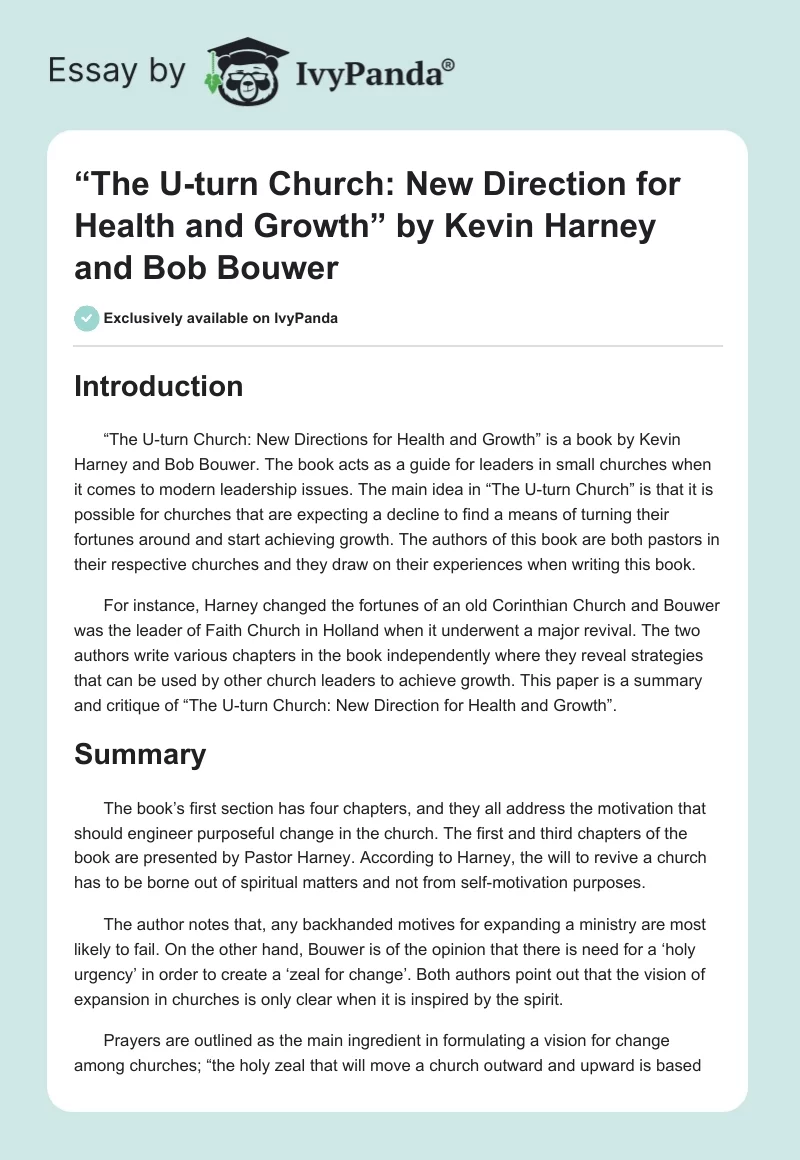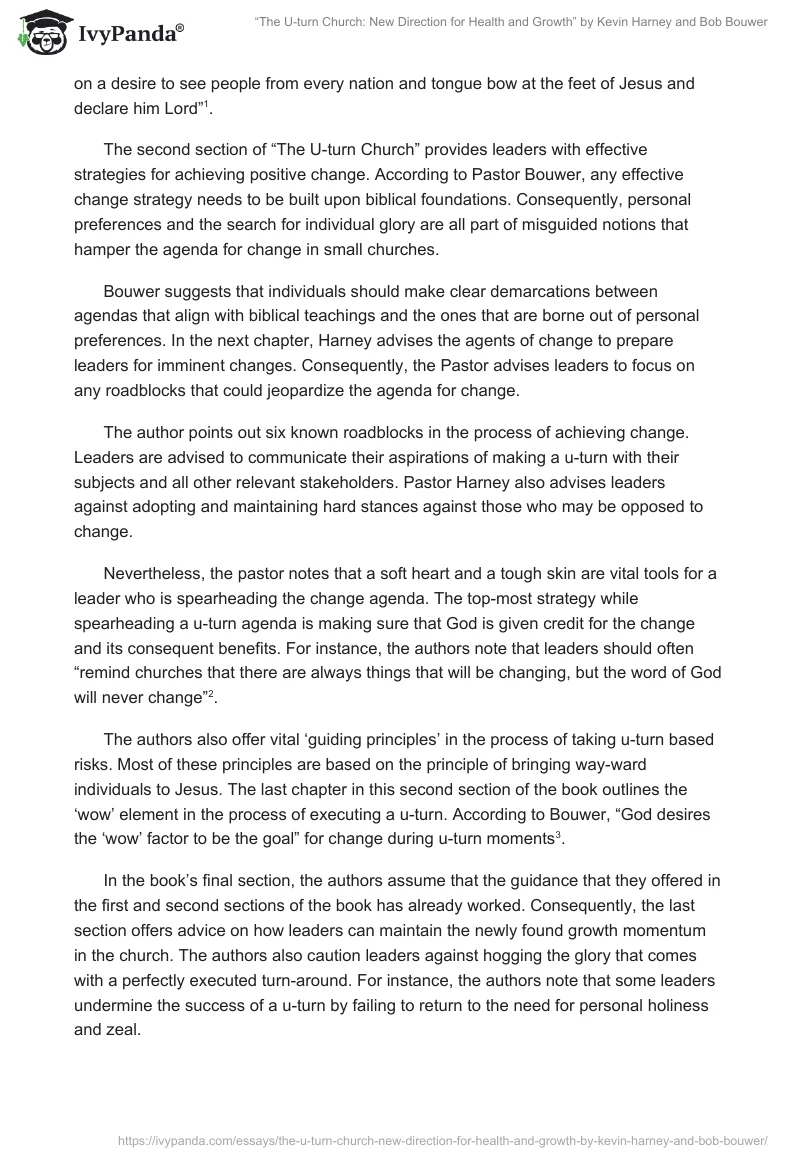Introduction
“The U-turn Church: New Directions for Health and Growth” is a book by Kevin Harney and Bob Bouwer. The book acts as a guide for leaders in small churches when it comes to modern leadership issues. The main idea in “The U-turn Church” is that it is possible for churches that are expecting a decline to find a means of turning their fortunes around and start achieving growth. The authors of this book are both pastors in their respective churches and they draw on their experiences when writing this book.
For instance, Harney changed the fortunes of an old Corinthian Church and Bouwer was the leader of Faith Church in Holland when it underwent a major revival. The two authors write various chapters in the book independently where they reveal strategies that can be used by other church leaders to achieve growth. This paper is a summary and critique of “The U-turn Church: New Direction for Health and Growth”.
Summary
The book’s first section has four chapters, and they all address the motivation that should engineer purposeful change in the church. The first and third chapters of the book are presented by Pastor Harney. According to Harney, the will to revive a church has to be borne out of spiritual matters and not from self-motivation purposes.
The author notes that, any backhanded motives for expanding a ministry are most likely to fail. On the other hand, Bouwer is of the opinion that there is need for a ‘holy urgency’ in order to create a ‘zeal for change’. Both authors point out that the vision of expansion in churches is only clear when it is inspired by the spirit.
Prayers are outlined as the main ingredient in formulating a vision for change among churches; “the holy zeal that will move a church outward and upward is based on a desire to see people from every nation and tongue bow at the feet of Jesus and declare him Lord”.
The second section of “The U-turn Church” provides leaders with effective strategies for achieving positive change. According to Pastor Bouwer, any effective change strategy needs to be built upon biblical foundations. Consequently, personal preferences and the search for individual glory are all part of misguided notions that hamper the agenda for change in small churches.
Bouwer suggests that individuals should make clear demarcations between agendas that align with biblical teachings and the ones that are borne out of personal preferences. In the next chapter, Harney advises the agents of change to prepare leaders for imminent changes. Consequently, the Pastor advises leaders to focus on any roadblocks that could jeopardize the agenda for change.
The author points out six known roadblocks in the process of achieving change. Leaders are advised to communicate their aspirations of making a u-turn with their subjects and all other relevant stakeholders. Pastor Harney also advises leaders against adopting and maintaining hard stances against those who may be opposed to change.
Nevertheless, the pastor notes that a soft heart and a tough skin are vital tools for a leader who is spearheading the change agenda. The top-most strategy while spearheading a u-turn agenda is making sure that God is given credit for the change and its consequent benefits. For instance, the authors note that leaders should often “remind churches that there are always things that will be changing, but the word of God will never change”.
The authors also offer vital ‘guiding principles’ in the process of taking u-turn based risks. Most of these principles are based on the principle of bringing way-ward individuals to Jesus. The last chapter in this second section of the book outlines the ‘wow’ element in the process of executing a u-turn. According to Bouwer, “God desires the ‘wow’ factor to be the goal” for change during u-turn moments.
In the book’s final section, the authors assume that the guidance that they offered in the first and second sections of the book has already worked. Consequently, the last section offers advice on how leaders can maintain the newly found growth momentum in the church. The authors also caution leaders against hogging the glory that comes with a perfectly executed turn-around. For instance, the authors note that some leaders undermine the success of a u-turn by failing to return to the need for personal holiness and zeal.
Critique
The overall format of Bouwer and Harney’s book is quite practical because the authors have utilized useful introductions at the beginning of each chapter. In addition, the authors challenge the reader with reflective questions and exercises at the end of each chapter. The format of the book makes the book an engaging work of literature in respect to the study of theology. An individual can utilize the format of the book and make sure that he/she covers a topic per week thereby having enough time for a reflection.
The authors’ main goal was to offer useful guidance to small-churches that might be interested in doing a u-turn. However, some of the examples that are offered by the author may not be applicable to the basic elements of a small church. For instance, it is important to note that both of the churches that are used as case studies for this book had stagnated but they were not in a decline. Consequently, the strategies that are outlined by the authors serve the purpose of a ‘revival’ as opposed to u-turns.
A u-turn occurs when a negative growth trajectory is turned in a positive or vice versa. In the case of Pastor Bouwer’s Faith Church in Holland, its fortunes changed after it shifted from its area of operation. A closer examination reveals that the church moved into an area whose population growth was on an upward trajectory. Consequently, the most significant agent for a u-turn in Bouwer’s case was the move from Holland to Indiana, a more vibrant community.
On the other hand, Harney’s church grew when it moved to the outskirts of Byron. The growth rates that were achieved by both churches appear to have been aided by the basic population growth-rates in their new territories. Consequently, it is not yet clear if the solutions that are offered by the authors can apply to the majority of small churches that are facing decline as a result of dwindling populations.
A keen observer can rule out the success of the authors’ churches as mere coincidence. Most of the churches that the book aims to help are in decline because the populations in their areas of operation are falling. The authors do not address this angle of u-turns in a satisfactory manner.
The author’s take on the differences between biblical absolutes and personal preferences are quite helpful and substantial to the modern Christian lifestyle. According to the authors, many churches struggle with the need to adhere to personal-preference agendas. For instance, most church leaders are likely to use biblical references while pushing for personal agendas. Consequently, the ability to differentiate between biblical absolutes and personal preferences remains a tricky issue.
Most quagmires of this nature often involve the music styles, personal dress codes, interior decorations, pastors’ level of education, and political alignments among other issues. These issues and the manner in which they are handled might have a defining impact on a small church’s ability to execute a u-turn.
The authors of this book offer helpful insights to leaders who might be seeking to find guidance on how to navigate spiritual versus personal agendas. The anxiety that comes with change adds to the complexity of the matter but the authors advise leaders to understand that the word of God remains constant.
Some of the chapters that are contained in this book are too ‘light’ when it comes to their subject matter. For instance, the authors appear to be too brief in chapter thirteen. More material is required in respect to how leaders should deal with the success that comes with functional u-turns. For instance, the authors should have offered more bible quotations in respect to this subject matter.
Overall, “The U-turn Church” is a good read that could be of benefit to both small church leaders and laymen. The book’s subject matter is also timely because either most churches have reached a plateau, or they are on a downward spiral. The book serves as a motivation to all individuals who might be struggling with declining church attendances in respect to their faith matters.
Bibliography
Harney, Kevin, and Bob Bouwer. The U-turn Church: New Direction for Health and Growth. New York: Baker Books, 2011.


